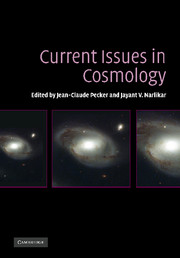Book contents
- Frontmatter
- Contents
- List of contributors
- Preface
- Part I Observational facts relating to discrete sources
- Part II Observational facts relating to background radiation
- 4 CMB observations and consequences
- 5 Abundances of light nuclei
- 6 Evidence for an accelerating Universe or lack of?
- Part III Standard cosmology
- Part IV Large-scale structure
- Part V Alternative cosmologies
- Part VI Evidence for anomalous redshifts
- Part VII Panel discussion
- Index
6 - Evidence for an accelerating Universe or lack of?
Published online by Cambridge University Press: 15 December 2009
- Frontmatter
- Contents
- List of contributors
- Preface
- Part I Observational facts relating to discrete sources
- Part II Observational facts relating to background radiation
- 4 CMB observations and consequences
- 5 Abundances of light nuclei
- 6 Evidence for an accelerating Universe or lack of?
- Part III Standard cosmology
- Part IV Large-scale structure
- Part V Alternative cosmologies
- Part VI Evidence for anomalous redshifts
- Part VII Panel discussion
- Index
Summary
Abstract
There is now a large consensus on the preferred cosmological model, which is known as the concordance model. This model relies on the introduction of a cosmological constant that represents the dominant form of energy densities in the present-day Universe. I briefly discuss the fact that from an astrophysicist point of view the evidence for a cosmological constant, although compelling, is not of sufficient robustness to consider that its existence has been demonstrated beyond reasonable doubt. I present the preliminary results of the Ω project, a large XMM program devoted to observing distant SHARC clusters. For the first time a measurement of the L–T evolution with XMM has been obtained. We found clear evidence for a positive evolution of the L–T relation, in agreement with most previous analysis based on ASCA and Chandra observations. Its cosmological implication is also discussed based on a new analysis of different X-ray surveys: EMSS, RDCS, MACS, SHARC, 160 deg2. It is found that a high matter density model fits remarkably well all these surveys, in agreement with all existing previous analyses following the same strategy. Concordance models produce far more high redshift massive clusters than observed in all existing X-ray surveys. This failure could indicate a deviation from the expected scaling of the M–T relation with redshift. However, no signature of such a possibility is found in existing data. I conclude that the properties of distant X-ray clusters as evidenced by XMM provide reliable indication in favor of an Einsteinde Sitter universe.
- Type
- Chapter
- Information
- Current Issues in Cosmology , pp. 76 - 84Publisher: Cambridge University PressPrint publication year: 2006
- 4
- Cited by



